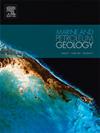Improved representation of sub-wireline scale lithological heterogeneity in geological models
IF 3.7
2区 地球科学
Q1 GEOSCIENCES, MULTIDISCIPLINARY
引用次数: 0
Abstract
Siliciclastic reservoirs often comprise lithological heterogeneity at mm-to cm-scales in the form of fine laminations of intraformational baffles. Such heterogeneities enhance capillarity and are often enriched in clay minerals such as chlorites. These properties could significantly influence subsurface fluid flow and fluid rock reactions. However, these heterogeneities are difficult to represent in geological models primarily because they exist at a scale which is below the resolution of conventional wireline logs. This paper presents an approach for deducing such heterogeneities using a combination of core plug and wireline log data to derive rock types capturing variations in intraformational baffles. The rock types were further populated in geological models to honour a nested representation of heterogeneity ranging from seismic to core plug scale. We also present a new upscaling method to ensure that cm-scale discrete rock properties are not lost to averaging. The study shows that property models derived using the conventional geo-modelling approach could overestimate porosity by about 20–30% for the sections with cm-scale laminations. Additionally, wireline log derived permeability values were found to be inconsistent with heterogeneity in fine laminations as observed in core plugs. The proposed approach attempts to overcome this issue by upscaling permeability in a way that honours variations in intraformational baffles.
求助全文
约1分钟内获得全文
求助全文
来源期刊

Marine and Petroleum Geology
地学-地球科学综合
CiteScore
8.80
自引率
14.30%
发文量
475
审稿时长
63 days
期刊介绍:
Marine and Petroleum Geology is the pre-eminent international forum for the exchange of multidisciplinary concepts, interpretations and techniques for all concerned with marine and petroleum geology in industry, government and academia. Rapid bimonthly publication allows early communications of papers or short communications to the geoscience community.
Marine and Petroleum Geology is essential reading for geologists, geophysicists and explorationists in industry, government and academia working in the following areas: marine geology; basin analysis and evaluation; organic geochemistry; reserve/resource estimation; seismic stratigraphy; thermal models of basic evolution; sedimentary geology; continental margins; geophysical interpretation; structural geology/tectonics; formation evaluation techniques; well logging.
 求助内容:
求助内容: 应助结果提醒方式:
应助结果提醒方式:


